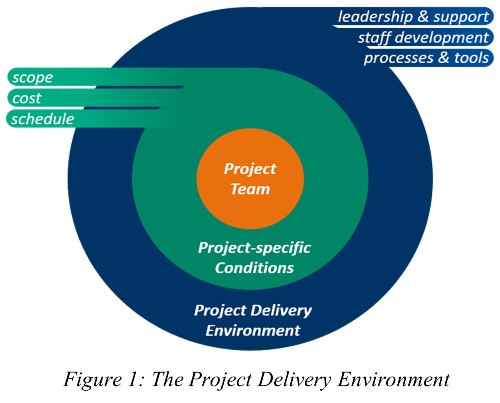A Quantitative Approach to a Qualitative Dialogue
ADVISORY ARTICLE
By Ryan Daugherty
Washington, USA
Overview
Adding value in today’s global marketplace is accomplished more through teams of people working together on projects than any other work platform.
While project-specific conditions may drive individual project success, the organization’s project delivery “culture” – organizational alignment, leadership engagement, development of project staff capabilities, supporting functions, processes, methods, tools – provides the foundation for collective delivery effectiveness and sustainable success.
Dimensions of the Project Delivery Environment
We tend to think of project success in three project-specific “dimensions” – scope, cost, and schedule. “Did we deliver what the client wanted within the budget and on time?” These, along with other project-specific measures, can give us a very accurate indication of our success for each project we deliver. In focusing on these project-specific measures, we can lose sight of the influence of the enterprise project delivery environment.
Experience indicates that several common attributes and characteristics define the enterprise project delivery environment. We have grouped the primary influences into three major “dimensions”:

Leadership and Organizational Support: The project delivery practice has a high level of focus and commitment from senior leadership. The organizational structure – including support groups – is centered on project delivery as a core enterprise competency.
Staff Knowledge and Development: The enterprise has a clearly defined career path for – and high value of – project delivery practitioners and is fully committed to the continuous development of staff knowledge and skills.
Processes and Tools: The delivery practice is committed to a core “model” of the project delivery “workflow” that provides practical and proven methods, guidance and tools geared to the capabilities of performing staff, and is consistently used day-to-day by all teams. The “model” is also used as the basis for learning and continuous improvement.
The “Box” Score
Developing a supportive Project Delivery Environment requires a sound understanding of current strengths and weaknesses and how they align with the attributes and characteristics of value to the enterprise and its project delivery teams. This understanding is frequently accomplished through comprehensive analyses of a wide range of delivery processes using project management “maturity” models, often involving outside consultants.
While there is significant value in that approach, we believe that there is equal value in identifying areas of strength and weakness and opportunities for improvement quickly and “organically” with internal resources. Enterprise leadership, project delivery participants, and stakeholders understand their situation – capabilities, capacities, needs, and constraints – better than any external source. And, there is much to be gained through the dialogue that takes place.
More…
To read entire article, click here
How to cite this article: Daugherty, R. (2021). The Project Delivery Environment Box Score: A Quantitative Approach to a Qualitative Dialogue, PM World Journal, Vol. X, Issue III, March. Available online at https://pmworldlibrary.net/wp-content/uploads/2021/03/pmwj103-Mar2021-Daugherty-project-delivery-environment-box-score.pdf
About the Author

Ryan Daugherty
Washington, USA
![]()
Ryan Daugherty is the designer/developer of the Process|SimpleTM Platform for Project/Process Knowledge Hubs. He has nearly 50 years of hands-on project delivery management experience with the Boeing Company, CH2M HILL (now Jacobs), among others. He has consulted on public and private sector projects worldwide. Email: RyanDaugherty@RyanDaugherty.com









